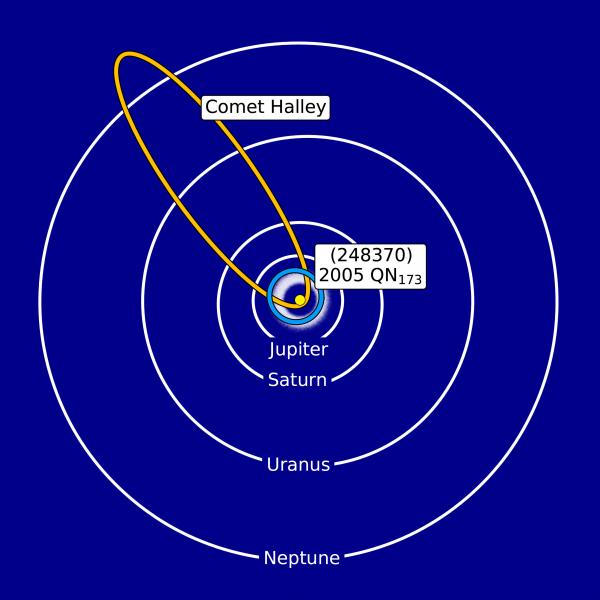In astronomy, comets and asteroids are defined very differently. Comets have a “nucleus,” usually made of ice and dust, and a tail when they get near the sun, which is the nucleus material shedding off from the comet itself. Asteroids, on the other hand, are small balls of rock orbiting the sun. Occasionally though, some objects meet the criteria to be both an asteroid and a comet – and a team from the Planetary Science Institute (PSI) think they have found a new one.
The object, 2005 QN173, is located in the main asteroid belt between Mars and Jupiter. It is one of only eight known main-belt objects to be “active” on more than one occasion. Being “active,” in this case, is defined as changing its orbital pattern due to something happening to the object specifically. Sublimation of ice on the object’s surface is the most likely cause of any activity in the case of 2005 QN173.
UT video discussing the asteroid belt.That activity is what makes this object unique when compared to other asteroids in the belt. Any ice that might cause sublimation would have been burned off billions of years ago, as they have been exposed to the full force of the sun for that long. On the other hand, comets are only subjected to that solar power when on the perihelion of their, sometimes very eccentric, orbit. While farther away from the sun, solar radiation has little to no effect on the ice the comet contains.
So it is a bit surprising when scientists find an object that outgasses like a comet but is in the same position as billions of other asteroids. In this case, the author of the new paper on 2005 QN173 is also the person that discovered this whole category of unique objects, now called main-belt comets.
UT video discussing comet tailsOne distinguishing feature of 2005 QN173 itself, though, is its cometary tail. The object’s nucleus is standard enough, with a 3.2 km (2 miles) wide cloud around it. However, the object’s tail is strangely shaped. It is more than 720,000 km (450,000 miles) long and only 1,400 km (900miles) wide. As described in a press release from PSI – “if the length of the tail was scaled to the length of a football field, it would be just 7 inches wide, and the nucleus would be half a millimeter across.”
This elongated, skinny tail means that the particles it is formed out of are only leaving the object’s surface very slowly. However, solar pressure is probably not enough to eject the dust particles off the surface to form a tail. Henry Hsieh, a Senior Scientist at PSI and lead author of the paper, thinks that the 2005 QN173’s rotation might help contribute to the energy needed for dust to escape but cautions that more observations are required before finalizing any models of the object or similar ones.
 Comparison of the orbits between a standard comet (Halley’s) and 2005 QN173.
Comparison of the orbits between a standard comet (Halley’s) and 2005 QN173.
Credit – Henry H. Hsieh (PSI)
Long ago, similar objects might have been the source of much of Earth’s water. Models of the early planet suggest that a lot of the water Earth currently holds was initially delivered by main-belt asteroids in the early life of the solar system. If that model is accurate, then studying anything that still looks like a comet after billions of years in the asteroid belt could help to prove or disprove that theory.
Learn More:
PSI – Is New Finding an Asteroid or a Comet? It’s Both
arXiv – Physical Characterization of Main-Belt Comet (248370) 2005 QN173
Sciencealert – Weird Space Rock Confirmed as Super-Rare Hybrid of Comet And Asteroid
Space.com – Is it an asteroid or comet? This strange solar system object is actually both.
Lead Image:
Composite image of 2005 QN173, whose tail can be seen going from the upper left to the bottom right.
Credit – Henry H. Hsieh (PSI), Jana Pittichová (NASA/JPL-Caltech)

